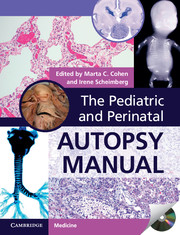Book contents
- Frontmatter
- Contents
- List of contributors
- Foreword
- Preface
- Acknowledgments
- 1 Perinatal autopsy, techniques, and classifications
- 2 Placental examination
- 3 The fetus less than 15 weeks gestation
- 4 Stillbirth and intrauterine growth restriction
- 5 Hydrops fetalis
- 6 Pathology of twinning and higher multiple pregnancy
- 7 Is this a syndrome? Patterns in genetic conditions
- 8 The metabolic disease autopsy
- 9 The abnormal heart
- 10 Central nervous system
- 11 Significant congenital abnormalities of the respiratory, digestive, and renal systems
- 12 Skeletal dysplasias
- 13 Congenital tumors
- 14 Complications of prematurity
- 15 Intrapartum and neonatal death
- 16 Sudden unexpected death in infancy
- 17 Infections and malnutrition
- 18 Role of MRI and radiology in post mortems
- 19 The forensic post mortem
- 20 Appendix tables
- Index
- References
1 - Perinatal autopsy, techniques, and classifications
Published online by Cambridge University Press: 05 September 2014
- Frontmatter
- Contents
- List of contributors
- Foreword
- Preface
- Acknowledgments
- 1 Perinatal autopsy, techniques, and classifications
- 2 Placental examination
- 3 The fetus less than 15 weeks gestation
- 4 Stillbirth and intrauterine growth restriction
- 5 Hydrops fetalis
- 6 Pathology of twinning and higher multiple pregnancy
- 7 Is this a syndrome? Patterns in genetic conditions
- 8 The metabolic disease autopsy
- 9 The abnormal heart
- 10 Central nervous system
- 11 Significant congenital abnormalities of the respiratory, digestive, and renal systems
- 12 Skeletal dysplasias
- 13 Congenital tumors
- 14 Complications of prematurity
- 15 Intrapartum and neonatal death
- 16 Sudden unexpected death in infancy
- 17 Infections and malnutrition
- 18 Role of MRI and radiology in post mortems
- 19 The forensic post mortem
- 20 Appendix tables
- Index
- References
Summary
The perinatal autopsy
The value of the perinatal autopsy
The perinatal autopsy can provide important information to the family, the clinician, and society [1–3]. When the parents give their consent for a post mortem examination on their baby, they are hoping to know why and how their baby died. It is quite reassuring to the parents to know that whatever has gone wrong, it did not happen because they did something wrong, and that there was nothing they could have done to prevent it. In cases where the pregnancy was terminated due to malformations, the post mortem can confirm, modify, or exclude a prenatal diagnosis, i.e., it serves as an audit tool for both diagnosis and diagnostic techniques. In all cases, whether it was a miscarriage, a stillbirth or a termination of pregnancy due to fetal malformations, the information obtained from the autopsy can help both the parents and the clinicians to plan for future pregnancies, and help the clinicians to counsel the parents about possible recurrence risks.
In cases of neonatal deaths, the perinatal autopsy can provide the neonatologists with information about the accuracy of their diagnoses and any conditions that were not recognized. It can also provide information about the effects of various treatments and drugs on the tissues and organs.
The autopsy is an important teaching tool for a variety of health professionals involved in the care of women and their babies. This includes pathologists, pediatricians, neonatologists, obstetricians, midwives, nurses, and bereavement officers.
The perinatal autopsy provides information that can be used to promote public health. Accurate information on causes of death is essential for national perinatal mortality data and health service planning.
- Type
- Chapter
- Information
- The Pediatric and Perinatal Autopsy Manual , pp. 1 - 16Publisher: Cambridge University PressPrint publication year: 2000
References
- 2
- Cited by



